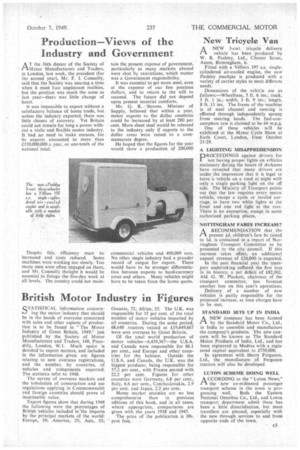Production—Views of the Industry and Government
Page 41

If you've noticed an error in this article please click here to report it so we can fix it.
AT the 36th dinner of the Society of ,Motor Manufacturers and Traders, in London, last week, the president (for the second year), Mr. F. 1. Connolly, said, that the Society was nearing a time when it must face unpleasant realities, but the position was much the same as last year—there was little change of hea rt.
It was impossible to export without a satisfactory balance of home trade, hut unless the industry exported, there was• little chance of recovery. Yet Britain could not remain for long a power without a virile and flexible motor industry. It had no need to Make excuses, for its exports amounted to more than £150,000,000 a year, or one-tenth of the national total.
Despite this, efficiency must be increased and costs reduced. Some machines were working too slowly. Too many men were often engaged on them, and Mr. Connolly thought it would be essential to forego the five-day week at all levels. The country could not main tam n the present expense of government, particularly as many markets abroad were shut by restrictions, which matter was a Government responsibility.
It was essential to get more steel, even at the expense of our few precious dollars, and to return to the will to succeed. The future did not depend upon present material comforts.
Mr. G. R. Strauss, Minister of Supply, believed that within a year, motor exports to the dollar countries could be increased by at least 200 per cent. More sheet steel would be released to the industry only if exports to the dollar areas were raised to a commensurate degree.
He hoped that the figures for the year would show a production of 200,000 commercial vehicles and 400,000 cars. No other single industry had a prouder record of output for export. There would have to be stronger differentiation between exports to hard-currency areas and others. Many vehicles might have to be taken from the home quota.




































































































